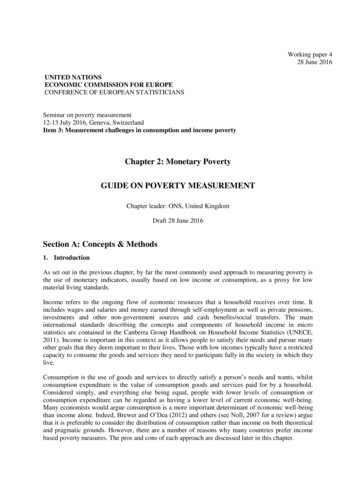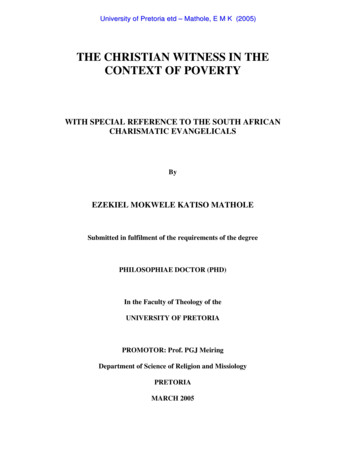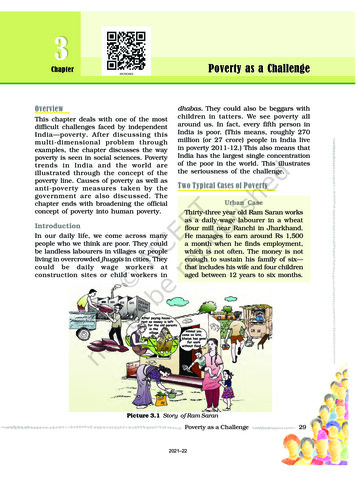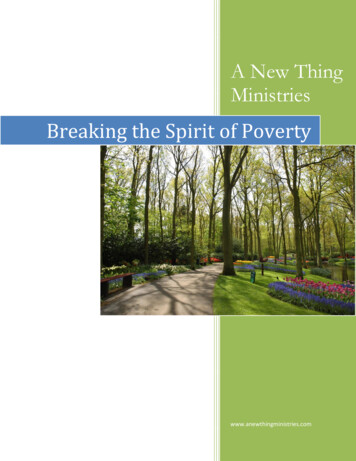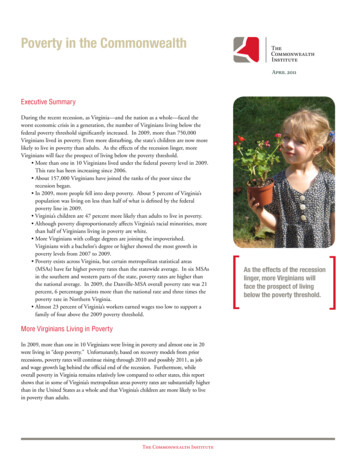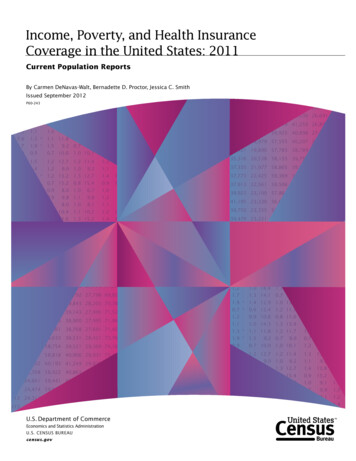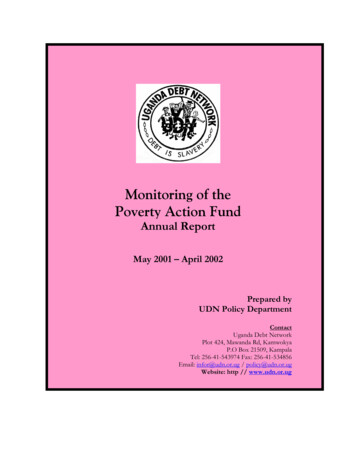
Transcription
Monitoring of thePoverty Action FundAnnual ReportMay 2001 – April 2002Prepared byUDN Policy DepartmentContactUganda Debt NetworkPlot 424, Mawanda Rd, KamwokyaP.O Box 21509, KampalaTel: 256-41-543974 Fax: 256-41-534856Email: infor@udn.or.ug / policy@udn.or.ugWebsite: http // www.udn.or.ug
UGANDA DEBT NETWORKReport of monitoring the Poverty Action FundAnnual Report May 2001- April 20021.1IntroductionUganda Debt Network (UDN) is a pro-poor organization advocating for reduced andsustainable debt levels, accountability and effective use of national resources for thebenefit of all the people of Uganda. The Network is an advocacy and lobbying coalitionof NGOs, institutions and individuals formed in 1996. The network was formed as aresult of civil society concerns that Uganda's debt burden had reached unsustainablelevels, which had serious adverse implications for social development. Since itsformation UDN has become a focal point for critical advocacy issues and facilitator ofcivil society organisations for advocacy and lobbying.UDN has been involved in various activities aimed at strengthening the capacity of civilsociety to engage Government and to influence policy planning in Uganda. The Networkhas carried out the following activities: Spearheaded the Jubilee 2000 global debt cancellation campaign in UgandaFacilitates the civil society in monitoring the implementation of the Poverty ActionFund, a mechanism instituted by the Government of Uganda to mobilise debtsavings and channel them in poverty reducing programmes. Was a lead agency in the CSOs Task Force for the revision of the PovertyEradication Action Plan (PEAP) and preparation of Poverty Reduction StrategyPaper (PRSP) Spearheads the Budget Advocacy Initiative (BAI) composed of organisationsworking on budgetary analysis, advocacy and research Spearheaded the Anti Corruption Coalition of Uganda (ACCU), a loose coalition ofCSOs, and individuals concerned about rampant corruption in Uganda.1.2VisionA prosperous Uganda with equitable development and a high quality of life of the people1.3MissionTo advocate for reduced sustainable debt levels, accountability and effective use ofnational resources for the benefit of all the people of Uganda.1.4How does UDN work?UDN’s advocacy and campaign work is through mass mobilisation, capacity building ofCSOs, media, research, publications and information dissemination through newsletters,briefing papers, updates, workshops, meetings, seminars, conferences e.t.c.2
2.1Advocacy on Debt Relief and cancellationUDN was formed to primarily campaign for debt relief for Uganda under the HighlyIndebted Poor Countries (HIPCS) initiative of the World Bank and IMF to reduce debtsof poor countries. It was also to ensure that the savings from debt relief are spent in thesocial sector so as to reduce poverty. The network was the lead agency for the debt reliefin Uganda under the Highly Indebted Poor Countries (HIPCS) initiative of the WorldBank and IMF from 1996 to 2000. UDNs support and successful participation in theJubilee 2000 Global debt cancellation campaign saw Uganda among the first countries toreceive debt relief under the HIPCS initiative in 1998 with evident benefits for povertyreduction. The government is committed to spending debt relief resources on povertyeradication through Poverty Action Fund (PAF)The Poverty Action Fund (PAF)This is a mechanism that the Government of Uganda established in the Financial Year of1997/98 to mobilise additional resources for expenditure in the social sector to alleviatepoverty. The source of funding for the PAF is savings from the HIPC Debt ReliefInitiative, donor contributions and the Government of Uganda own resources. This2001/02 Financial Year is the fourth year of operation of PAF and contributes 35.30%of the national budget of Uganda. PAF resources are sent to the districts as conditionalgrants and are supposed to be used according to the guidelines established by Ministry ofFinance, Planning and Economic Development as well as the line ministriesProgramme areas under the PAFPAF provides funding to PEAP priority areas that are directly poverty reducing througheither: Increasing the ability of the poor to raise their incomes, or Improving the quality of life of the poor, andPAF funded programs include: Primary EducationPrimary Health CareWater and Sanitation developmentRural Feeder roads maintenanceAgriculture extensionMicro Finance/ Restocking programmesOthers include Control of HIV/AIDS, pilot schemes for adult literacy andenhancing efficiency in the Judiciary system (clearance of the case backlog).Monitoring and accountability of PAF funds5% of the total PAF resources is allocated to Government agencies that are involved inensuring that public resources are not misappropriated. The 5% of these resources is setaside to ensure improved effectiveness, transparency and accountability of use of theseresources. The benefiting Government agencies from the 5% are: The Inspectorate of Government The Auditor General3
The Public Accounts CommitteeThe Inspectorate Department under the Ministry of Local GovernmentThe Directorate of Accounts under Ministry of Finance, Planning and EconomicDevelopment.3.1The role of UDN in monitoring PAFUDN is a Civil Society Organization (CSO) monitoring the implementation andutilization of Poverty Action Fund to ensure that resources from debt relief are spent onpoverty focused programmes and also that services reach the intended beneficiaries. InMay 2000, UDN beefed up the process of monitoring by establishing grassrootsstructures, the Poverty Action Fund Monitoring Committees (PAFMCs). The PAFMCsare voluntary Civil Society groups comprised of grassroots communities and exist in 17districts1 in Uganda where UDN is operating.Initially, the PAFMCs were established in 12 districts. They have now expanded from theoriginal with extra five districts that formed structures out of their own initiative afterlearning from others. These include Kaberamaido, Soroti, Katakwi2, Kanungu andIganga. Many other districts are expressing their enthusiasm to join the process such asMayuge, Mbarara, Ntungamo, Hoima and Nebbi. This has come about as a result of theawareness and education created over the last two years.UDN has encouraged PAFMCs to establish structures from the district to the lowestvillage level. This will be the basis on which continuous monitoring will be enhanced atthe community level. Such structures exist in the districts of Katakwi, in some counties,Kaberamaido, Soroti, Lira and Kamuli.3.1.1Introducing the Community Based Monitoring and EvaluationSystem (CBMES)In response to the challenges of monitoring PAF and other intervention mechanisms,which include limited numbers of monitors at the district level, UDN has had to reshapethe strategy of monitoring done by a few PAFMCs to the Community Based Monitoringand Evaluation System (CBMES).The CBMES aims to empower communities to articulate their development needs andpriorities, as well as efforts to mobilise communities in the local development planning,management, and evaluation process of service delivery. The initiative entails localcommunities measuring the performance of government programmes by obtaininginformation about the quality and quantity outputs over a certain period of time andcomparing this with the publicly declared outputs of those programmes.This method not only offers the opportunity for tracking and monitoring governmentdecision making but also involves constituencies in research, empowerment and buildingcapacity to bring about significant change and facilitating in depth learning by largenumbers of people on the issues which concern them.1 Kamuli, Katakwi, Kaberamaido, Soroti, Apac, Lira, Bugiri, Pallisa, Bushenyi, Iganga, Kanungu, Rukungiri, Kumi,Mpigi, Luwero , Kiboga, Mbale2 It is however noted that the three districts of Kaberamaido, Soroti and Katakwi have been taken up as PAFMCs asresult of additional funding from other partners such as DANIDA. This has contributed to the resources provided byOxfam that has enabled UDN to facilitate the increasing number of PAFMCs structures.4
It is envisaged that the CBMES will involve communities in large numbers to participatein monitoring and also supplement the work of PAFMCs3.1.2The CBMES Pilot in KamuliUDN carried out a pilot in the district of Kamuli from 11th – 23rd April 2002 to test theCommunity Based Monitoring and Evaluation System (CBMES), to seek involvement ofrespective stakeholders and test its feasibility (see full report of the Pilot in Annex- I)The goal of the pilot was to establish a Community Based Monitoring & EvaluationSystem (CBMES) to enhance participation of local communities in decision-making andpolicy influence.The purpose of the pilot was to empower grassroots communities to monitor povertyand other development-related programmes, participate in programme and policymonitoring and evaluation for socio-economic change.The Objectives of the pilot included introducing participatory monitoring andevaluation skills to local communities, developing a tool for monitoring and evaluatingcommunity poverty programmes, establishing a community based informationmanagement system and drawing lessons for scaling up community based monitoringand evaluation for replication elsewhere.Methodology of the Pilot Courtesy calls on district and sub-county officials. Mobilisation of communities done by Poverty Monitoring Committees (PMCs). Meeting held between UDN and PMCs to develop the selection criteria of pilot areasand community representatives. Meetings held under trees and shop verandahs to select community representatives. Workshops held at sub-county and district levels for training and debriefing offindings. Participatory methodologies used in training, identifying the priority areas formonitoring, developing monitoring tool and indicators and analysis of findings. By the nature of the information collected, qualitative data analysis was used.Key Outcomes of the Pilot Participatory monitoring and evaluation skills were shared with the participantsduring the training workshop. A tool for monitoring and evaluating development programmes was developed bythe participants and tested for data collection in the area. A Community Based Information Management and Action system was developed. Lessons for scaling up community based monitoring and evaluation for replicationelsewhere were drawn.Challenges of the system Poverty levels in the community can influence the monitors in accepting bribes toshy away from the truth.5
Availability of information on funds allocated and disbursed. Establishment of rapport with key stakeholders especially government officials, localleaders and implementers of the programmes. Inadequate skills in monitoring and evaluation M&E by those who are going tomonitor. Lack of prompt action on monitored issues may discourage the communities tosupport the system. Lack of a code of conduct for the members may derail the system.ConclusionThe CBMES is a practical system useful in monitoring development and anti-corruptionefforts in government and society.Lessons learned The CBMES process can be adapted to suit other UDN programmes like budgetwork and good governance. Adequate mobilization of communities is important before the process of CBMES. Service delivery can greatly be influenced by community participation in M&E ofdevelopment programmes. This will enhance accountability in terms of outputs. Communities once empowered in terms of information and skills can play a greatrole in directing their development needs.Way forward Present findings to the Poverty Monitoring Analysis Unit. Assess training needs of the CBMs (esp. new ones) in June 2002 Follow up of the Community-Based Monitors quarterly by UDN at least in the firstyear of the pilot. Organise media events to discuss the findings.3.1.2 Critical issues of CSOs MonitoringOverseers of proper implementation of PAF programmes.Advocates for transparency, accountability as well as watchdogs in checkingoccasions of corruption at the local Government and lower levels of governance.Ensure proper channels of service delivery at the grassroots and provision offeedback mechanisms for action to UDN and Policy makers and respectivestakeholders.3.1.3Integration of PAF monitoring with other programmesBecause of the nature of work UDN does which involves influencing pro-poor policyplanning at national and international level it has been imperative to integrate most of theprograms. The concept of PAF monitoring is being transformed from standing isolatedto integration with other pertinent programmes. The most significant element is that, thestructures of PAFMCs propel other activities to take pace at the grassroots such as;Grassroots anti corruption campaign, Budget Advocacy, Linkages between PEAP andPAF, linking partners with Public Information Centre, e.t.c. This is advantageous in asense of: sharing of resources; cost effectiveness in terms of time, human and financial6
resources; capacity building; information dissemination and coverage in terms ofconstituencies covered. Significantly, the programs are mutually supporting andinterrelated. This provides opportunities for expansion of PAF monitoring to widerconstituencies.3.1.4Composition of the CommitteesThe committees are composed of persons selected from the civil society sectionsincluding women, youth, people with disabilities (PWDs), men, religious leaders, and theelderly. Each Committee has been formed with specific portfolios namely Chairperson,Vice Chairperson, Secretary, Publicity Secretary, Treasurer, and Committee Memberscomprising on average 10 members.Sub-county and Parish committees though they are representatives of civil societycreated in some districts, may not realize the same number of portfolios. They arecomprised of a few members on average four (4) members. They converge at therespective levels of operation for strategic meetings to discuss and draw strategies formonitoring the PAF.4.1Skills Development WorkshopsUDN believes that communities should be empowered to have voice and influencedecision-making processes at national and grassroots level. The committees are beingequipped with skills and knowledge in poverty and public expenditure (budgetaryresources) monitoring, grassroots advocacy and lobbying to ensure accountability andeffective implementation of programmes. During the second half of 2001, two skillsdevelopment workshops were organized to build the capacity of PAFMCs to enhancetheir monitoring work.4.1.2Lobby and Advocacy WorkshopThis was organised for Grassroots Partners in the fight against Corruption and PAFMCsto further the process of integrating PAF monitoring with Grassroots anti corruptioncampaign. The workshop was held at Cardinal Nsubuga Leadership Centre, Kampalafrom 28th -29th June 2001.Participants at the workshop were drawn from the then 13 districts where UDN wasoperating at that and representatives of groups UDN had been working with at thegrassroots on anti-corruption campaign were also involved. These include: ORAG, EchoDrama Actors, MWODET from Soroti, Rukungiri, Kanungu, and Mpigi respectively anda representative from Kaberamaido District who had initiated PAF Committees. Inorder to strengthen coalition building between CSO and local government in the struggleagainst corruption, a District Cultural Officer from each of the districts was invited forthis workshop. This made the total number of participants to 49 (30 Males and 9Females)Achievements of the Lobby and Advocacy workshop26 PAFMCs acquired lobby and advocacy skills; 7 partners from grassroots organizationsinvolved in the campaign acquired similar skills as above; 17 District Cultural Officersfrom trained with our partners and acquired similar skills; understanding of UDN7
concept of integrating PAF with other programs; set a pace for PAFMCs to draw activityplans for PAF monitoring and Anti Corruption activities in the respective districts;increased networking and collaboration between our partners at the grassroots anddistrict officials for the programs.Most significant, participants trained at this workshop immediately applied the skills bystarting a coalition called TESO Anti Corruption Coalition (TAC) comprising of 5districts.3 They have in addition to formation of a Coalition, initiated their own PAFMCsstructures in those districts that had none such as Kaberamaido, Soroti and Katakwi.They have made a step a head in mobilising people in the region to monitor PAF andadvocate for transparent and accountable systems.4.1.3Regional Skills Development WorkshopsIn the last Quarter of the year 2001, UDN changed the strategy of organising trainings inKampala since it was limiting full participation of all PAFMCs. This training round wasorganised at the regional level in three districts of Soroti, Iganga and Rukungiri as hostcentres. The training was conducted in the setting with in which PAFMCs. Theworkshops convened PAFMCs in the training according to their respective districts oflocation.They were categorised as follows:Eastern / Northern regionThe venue was Soroti district (Eneku Village) 11th – 17th November 2001 withparticipants hailing from 7 districts of Soroti, Katakwi, Kaberamaido, Apac, Lira, Pallisa,Kumi.Central / Eastern regionsThe venue was Iganga district (Iganga District Council Hall) 14th – 17th Nov. 2001 andparticipants came from the districts of Iganga, Kamuli, Bugiri, Kiboga.Western RegionThe Venue was Rukungiri district (Hotel Riverside) 20th – 23rd Nov. 2001 andparticipants came from the districts of Rukungiri, Kanungu and Bushenyi.Achievements of the skills Development workshops.Participation On the whole, the three training workshops were highly participatory and registereda good turn up of 161 participants. (including majority PAFMCs and other membersof civil society, district officials who expressed their desire to participate in thetraining) from 15 districts.4Facilitation and resource persons for the workshops 3The workshops were opened by the RDCs in the host districts with the exception ofSoroti where the RDC could not find time to participate. Resource persons in eachhost district included the CAO and the District Planner each making a presentationof a case a study of host District PAF budget allocations, Decentralisation Policy andTESO Anti Corruption Coalition is a launching pad for civil society groups operating in TESO region to contributeand participate effectively in the monitoring of poverty action programmes and anti corruption campaigns. It iscomprised of the following districts Kumi, Soroti, Pallisa, Kaberamaido, Katakwi.4The PAFMCs from the districts of Mpigi, Luwero and Mbale did not turn up due to failure to access information.8
opportunities available for PAFMCs to monitor PAF. The workshops were fullyfacilitated by one external Facilitator contracted by UDN and a Team of UDN Stafffrom the Policy and Campaigns Department. In all the workshops, facilitation was basedon the local experiences as one of the tools for training, which was beneficial for theparticipants’ conceptualisation and the setting with in which they do the monitoring ofPAF.Skills acquisition The training empowered participants with various skills including among others:understanding of the district budget formulation process; decentralization processand levels of civil society intervention; creating a cordial working relationship withlocal government authorities; advocacy and lobbying; communication skills; resourcemobilization; networking and campaigning skill; participatory planning; practicalmonitoring; data collection and reporting. Participants also had an opportunity todialogue and share their experience with Local Government Officials in a closedialogue with the PAFMCs. The training did not only benefit the PAFMCs but also some selected groups ofpeople who expressed interest in acquiring similar skills to enable them participate inmonitoring the PAF. This developed out of the interaction and opportunityprovided by the workshops that fostered a good relationship between localgovernment officials and UDN on learning the operations of PAFMCs in variousdistricts.District Dialogue meetings Each of the regional training workshops incorporated a PEAP dialogue thus 3dialogues were organised consecutively. They were organised in reference to casestudy presentations made by the host district Officials on implementation of PEAPat district level. The involvement of district officials demonstrated practicalapproaches and clarifications to the Partcipants on various issues such as; linkagesbetween PAF and PEAP; decentralization process; Implementation of PEAPthrough PAF funded programmes; operational mechanisms and opportunitiesavailable for PAFMCs at the district to the lower level in terms of access toinformation; contact offices/persons; PAF allocations and extra. The dialogues brought together PAF implementers at the district level and the civilsociety as the ultimate beneficiaries of the PAF. It was a great opportunity forsharing of experiences about implementation of the PAF and service delivery from across section of participants, District officials and facilitators. A few cases cited as opening up of district officials’ willingness to collaborate withPAFMCs include: the RDCs Office Iganga and Rukungiri, committed their office towork hand in hand with the PAFMCs. The CAOs in the three districts pledged theirsupport to UDN and PAFMCs. They promised to avail time and keep their officesopen as a point of reference for PAFMCs easy access of information and reporting.The CAO Iganga designated one of the ACAOs to work hand in hand with thePAFMCs in realising their objectives. It is envisaged that the training will improve the PAFMCs understanding of PEAP,PAF monitoring operations, and create a good operational relationship between9
PAFMCs and District Officials which in turn will help them in monitoring andreporting.Other District dialogues organised:Dialogues have been organized in 5 districts with participants coming from theneighbouring districts. Some of the dialogues coincided with various events that werepertinent to PAFMCs work such as the inauguration of PAFMC (Lira) restructuring ofinitial PAFMC (Rukungiri) and part of anti corruption events (TESO Conference andKumi). These include1.2.3.4.5.6.Lira Dialogue on 27th July 2001.TESO region conference held on 10th – 11th August, 20015Kamuli dialogue August 31, 2001,Rukungiri Dialogue on 26th October, 2001 andKumi public dialogue on November 23rd 2001The Leadership Code – CSOs consultations in Iganga and Soroti (convenedPAFMCs and other members of civil society from the districts of Soroti,Kaberamaido, Katakwi, , Pallisa, Kumi, Iganga, Mayuge, Kamuli, and Bugiri) march,2002.Media Campaign:The proceedings of the skills development workshops were recorded on WBS (a case ofIganga Workshop), which was aired on WBS Station on 18th November 2001 and thevisual tape provided for UDN archives. This received a lot of viewers from a crosssection of people in the central region of Uganda. In TESO region, 2 talk shows wereorganized for 8 PAFMCs, and 1 UDN staff to articulate the relevancy of the workshopsand PAF monitoring to the grassroots. The training also attracted the print Media inSoroti such as Etop the sister paper of The New Vision that incorporated it in the newsof the week.Other media events: Various media events had earlier been arranged in conjunctionwith pertinent events to PAF organised by UDN. A number of appearances in theelectronic and print media were made evident during: CG week 13th – 15th May 2001 40,000 copies of the pull out were produced in theMonitor backed with various articles, talk shows and interviews.Anti Corruption Week The whole month of October, and November 2001. –Various talk shows were organised on multiple FM radio stations and TV (both atnational and upcountry level). Participants in these programmes were PAFMCs,other UDN members and Staff who articulated critical issues of concern on Poverty,PAF monitoring and good governance in general.The National Poverty Day (Dialogue) – took place at the International ConferenceCentre 18th October 2001.The process of the CBM&ES Pilot test in Kamuli was covered in the press bothprint and electronic. The media houses involved included Wavah BroadcastingService (WBS) Television, Radio Uganda, Monitor FM, Radio Simba, the Monitorand New Vision Newspapers.5This dialogue unlike others that involved one district, was participated in by 5 districts that comprise TESO AntiCorruption Coalition (Kumi, Pallisa, Kaberamaido, Soroti, Katakwi)10
Issues arising from the regional workshops / DialoguesChallenges Though there are organs that fight corruption one can't know/justify the kind ofwork they are doing. PAFMCs appreciate the integration of PAF with Corruption but this should bebacked with regular trainings to facilitate adequate reporting. There should be sensitisation of councillors as well as local council leaders from thedistrict level to the lowest point to enable them become advocates of goodgovernance. The budget is not fully decentralised, even with national budget; sub county, localgovernment should be consulted. It is supposed to be participatory. High illiteracy levels of the grassroots people render them incapable of reading anypolicy document circulated. Need to sensitise leaders to enhance the process. Need to organize general meeting of all grassroots stakeholders at national level andstakeholders so that they can hear from each other.General challenges of PEAP/PAF implementation by the policy makers andimplementers a Improvement of the poverty monitoring systems at central and district levels remainschallenge.Capacity building at local governments to enhance effective planning, managementand implementation of the PEAP Improve accountability and transparency systems at the local government level. Enabling environment to promote growth in the private sector. Improve saving culture among the population.Recommendations Mass mobilisation /sensitisation of communities to ensure ownership and increasedparticipation in policy formulation and influence. Organise district dialogues between PAFMCs , implementers of PAF and other localleaders. Conduct capacity building trainings, meetings and workshops on poverty, monitoringand other related issues for the grassroots. Translation and simplification of key documents into popular languages, illustrationsfor easy reading to the grassroots. Dissemination of education documents and information. Meeting the logistical needs of PAFMCs and grassroots activities to enhancemonitoring and good governance.4.2Periodic / Continuous monitoringCivil society PAF monitoring involves NGOs/CBOs, PAFMCs/ CBMs, individuals andthe media. Our monitoring has enabled a cross section of people (Local, National andInternational) to get to know about the PAF and their role in monitoring. Most peoplehave got a chance to know about the PAF through publications produced and the11
electronic messages aired on radio and Television. As ultimate beneficiaries, knowing andmonitoring the PAF programme, increases ownership of the outputs. Classrooms built,roads maintained, rehabilitated health units are taken as property belonging to them. Thisthinking enhances utilization of the PAF outputs.The establishment of the PAFMCs not only improves the PAF implementation processbut also checks occasions of corruption. The PAFMCs have gained greater confidencefrom the public as a force to record grassroots complaints on service delivery. Reports ofmonitoring have triggered off serious intervention mechanisms by Civil Society and alsocompelled government officials to respond in a number of ways. Inadequacies in PAFimplementation process have been exposed in the PAFMCs reports of monitoring,which also UDN has forwarded to the relevant authorities. Some cases forwarded toUDN by PAFMCs include: Rampant embezzlement of public funds by Local Government Officials (sub-countycashiers and Chiefs as in the case of Butansi, (17m, 8m and 7m) since 1996/1997 andBugaya (36m) in Kamuli District. The issue of Graduated Tax in terms of paying more than 3,000/ for tickets worththis amount in Bugaya sub-county, Kamuli District. Polling Assistants who sign for 10,000/ but are actually paid 9,000/ in Bugayasub-county, Kamuli District. Mismanagement of funds and bribing of Local Council Officials by the Sub-countyChief, Kakanju, Bushenyi district. The case of the widow Iwangu Margaret versus Eastern division – Soroti MunicipalCouncil, over her plot No. 6 Aboosi Rd. The woman is reported to have reported tothe official to the IGG who took action and after some time the case was settled andthe woman given full control over her land (a case in Soroti District) Boda-boda cyclists in Soroti district were being charged an extravagant fee to operatein the district. TAC officials rounded them up and together they demanded anexplanation form the town clerk as to why they were being charged thus. Theconfrontation between the boda-boda guys and officials from the town clerk’s officewas so hot that the high fee was immediately dropped. A case of Amuria Farmers & Transporters, a construction firm that was contractedto build over 17 schools in Katakwi district. This has turned out to be scandalouswith millions of shillings lost through shoddy work. The case has been reported tothe various Anti Graft institutions, Parliament, and Local Government. As a result,the IGG Regional office in Soroti is investigating the matter. On the other hand in Kamuli, after the CBMES pilots exercise a number ofcorruption cases have emerged. These include reports of sinking latrines and crackedUPE buildings. In addition to this the people are also reported to
UGANDA DEBT NETWORK Report of monitoring the Poverty Action Fund Annual Report May 2001- April 2002 1.1 Introduction Uganda Debt Network (UDN) is a pro-poor organization advocating for reduced and sustainable debt levels, accountability and effective use of national resources for the benefit of all the people of Uganda.



